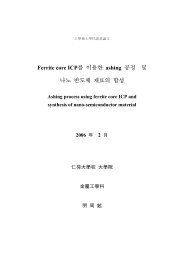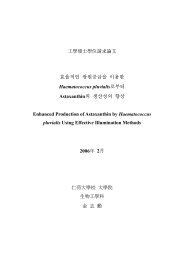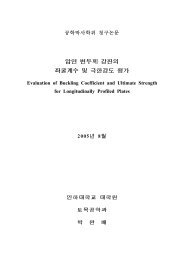저작자표시-비영리-변경금지 2.0 대한민국 이용자는 아래의 조건을 ...
저작자표시-비영리-변경금지 2.0 대한민국 이용자는 아래의 조건을 ...
저작자표시-비영리-변경금지 2.0 대한민국 이용자는 아래의 조건을 ...
You also want an ePaper? Increase the reach of your titles
YUMPU automatically turns print PDFs into web optimized ePapers that Google loves.
2. 1. Materials<br />
2. Experimental<br />
The Poly(butylene succinate)(PBS) used in this study was Enpol<br />
G4560 (MI = 1.5 g/10 min) from Ire Chemical LTD., Korea. MWNTs<br />
(HollowCNT 75L, purity of higher than 95%, inner/outer diameter<br />
distribution 30~50 / 60~80 nm) were purchased from Nanokarbon Co.,<br />
LTD., Korea. A high purity treatment using HCl and a density treatment<br />
were applied according to the manufacturer’s instructions. Chloroform<br />
was used as a solvent in the solution blending step and was supplied<br />
by Dongyang chemical, Korea. Cellecom ACP-4 acted as a chemical<br />
blowing agent (CBA) and was obtained by Kumyang Co., Korea. All<br />
materials were used without further purification.<br />
2. 2. Preparation of polymer nanocomposites<br />
In this work, three approaches were employed to evaluate the<br />
dispersion of MWNTs in the PBS matrix: solution blending, melt mixing,<br />
and the SOAM method (solution blending and subsequent melt mixing),<br />
respectively. PBS pellets and MWNTs were dried in a vacuum oven at<br />
60 o C for 24 h prior to being used. First, in the case of solution<br />
6







